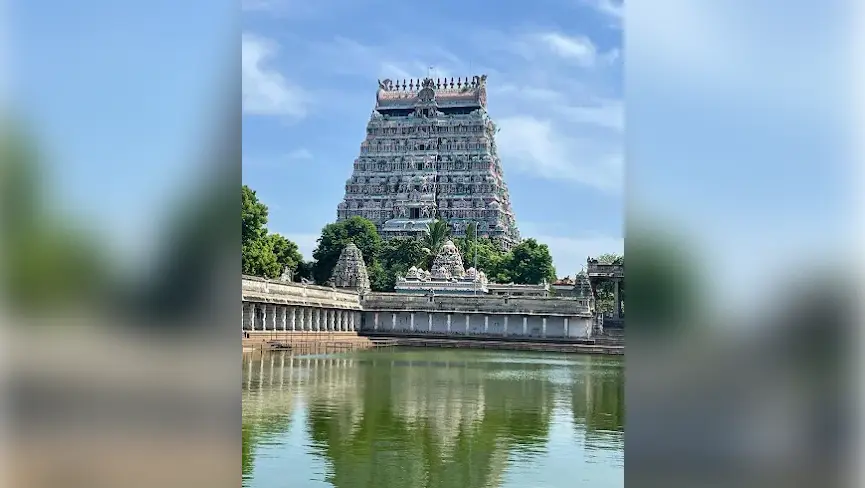
Chidambaram Nataraja Temple – Complete Pilgrimage Guide 2025
The Chidambaram Nataraja Temple, located in Tamil Nadu, is one of India’s most revered and mysterious temples dedicated to Lord Shiva in his dancing form—Nataraja. Known as one of the Pancha Bhoota Sthalams, representing the element of space (Akasha), this temple is a sacred destination for spiritual seekers, history lovers, and pilgrims.
Historical and Spiritual Significance of Chidambaram Nataraja Temple
The Chidambaram Nataraja Temple holds immense historical and spiritual importance in Hinduism, especially in the Shaivite tradition. It is one of the most sacred Shiva temples in India and forms part of the Pancha Bhoota Sthalams, representing the element of Akasha (space).
Ancient Chola Architecture
-
The temple’s origins trace back to the Chola dynasty in the 9th century CE, though it is believed that the original shrine existed even earlier.
-
It showcases a blend of Tamil architecture and Vedic symbolism, with richly sculpted gopurams (towers), intricate stone carvings, and bronze statues.
The Cosmic Dance of Lord Nataraja
-
Lord Shiva is worshipped here as Nataraja, the Cosmic Dancer, symbolizing creation, preservation, and destruction.
-
His Ananda Tandava (Dance of Bliss) in the gold-roofed sanctum (Kanaka Sabha) represents the rhythmic cycle of the universe.
-
The temple is unique in enshrining a murti (idol) of Nataraja, unlike most Shiva temples that have a Shiva Lingam.
Chidambara Rahasyam – The Divine Secret
-
One of the most profound aspects of the temple is the Chidambara Rahasyam—the "Secret of Chidambaram".
-
Behind a golden curtain in the sanctum, there is no idol, but instead a space with sacred threads representing formless Shiva (Akasha Lingam), signifying that God is both form and formless.
-
This powerful symbolism reveals deep Advaita (non-duality) philosophy—highlighting that the divine exists in all beings and beyond all forms.
Spiritual Relevance in Scriptures
-
The temple finds mention in ancient Tamil texts like the Tevaram hymns and Thirumurai.
-
Saints like Appar, Sundarar, and Manikkavacakar sang praises of Lord Nataraja here, elevating its spiritual status in Saiva Siddhanta tradition.
Symbol of Cosmic Energy
-
Chidambaram is considered the center of the universe in Shaivite cosmology.
-
It is believed that Shiva resides eternally here, performing the cosmic dance that governs the rhythm of life.
Chidambaram Nataraja Temple Timings
The Chidambaram Nataraja Temple is open daily for devotees and follows a traditional temple schedule with specific darshan and pooja timings. Pilgrims are advised to plan their visit during these hours to witness the sacred rituals and inner sanctum.
| Session | Timings |
|---|---|
| Temple Opening | 6:00 AM |
| Morning Poojas & Darshan | 6:30 AM – 12:00 PM |
| Temple Break | 12:00 PM – 5:00 PM |
| Evening Darshan | 5:00 PM – 10:00 PM |
| Temple Closing | 10:00 PM |
Daily Pooja & Seva Schedule
-
Paal Abhishekam – 6:30 AM
-
Kaala Santhi Pooja – 7:00 AM
-
Uchi Kaala Pooja – 11:30 AM
-
Sayaratchai Pooja – 6:30 PM
-
Ardhajama Pooja – 9:00 PM
Major Festivals Celebrated at Chidambaram Nataraja Temple
The Chidambaram Nataraja Temple is a vibrant center of religious celebrations and cultural festivals. Each festival here is marked by grand rituals, processions, abhishekams, music, and dance, reflecting the temple’s deep spiritual heritage and cosmic significance.
1. Arudra Darshan (Thiruvathirai)
-
Month: December–January (Margazhi Masam)
-
Significance: Celebrates Lord Shiva’s Ananda Tandava (cosmic dance).
-
Highlights:
-
Early morning abhishekam to Lord Nataraja.
-
Sacred procession of the Nataraja idol around the temple.
-
Considered the most important festival of the temple.
-
2. Aani Thirumanjanam
-
Month: June–July (Aani Masam)
-
Significance: Annual Utsava Abhishekam to the Nataraja idol.
-
Highlights:
-
Grand abishekam with holy ingredients.
-
Recitation of Vedic hymns.
-
Large devotee gatherings and special poojas.
-
3. Maha Shivaratri
-
Month: February–March (Maasi Masam)
-
Significance: The night of Lord Shiva’s cosmic union and dance.
-
Highlights:
-
All-night vigil and chanting.
-
Multiple abhishekams and special darshan.
-
Devotees fast and meditate throughout the night.
-
4. Navaratri
-
Month: September–October
-
Significance: Celebrates Devi worship and divine feminine energy.
-
Highlights:
-
Decorated shrine of Goddess Sivagami.
-
Traditional music, cultural programs, and poojas.
-
5. Panguni Uthiram
-
Month: March–April
-
Significance: Celestial wedding of Lord Nataraja and Goddess Sivagami.
-
Highlights:
-
Divine marriage ceremony performed with great devotion.
-
Colorful rituals and processions.
-
